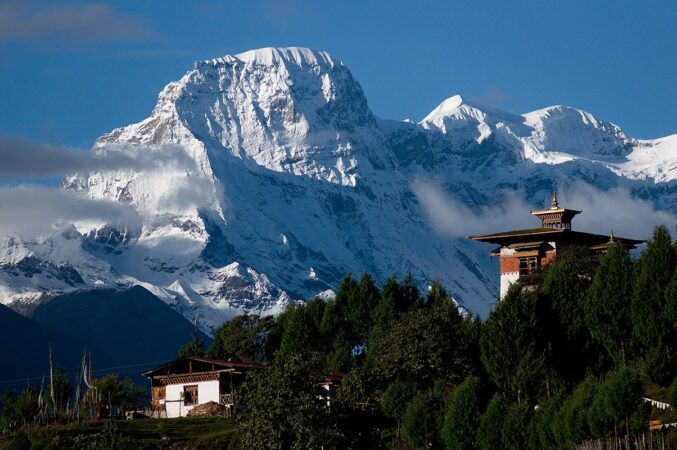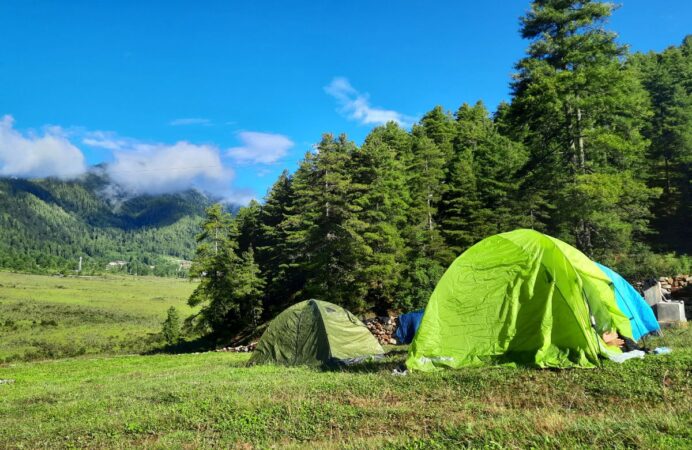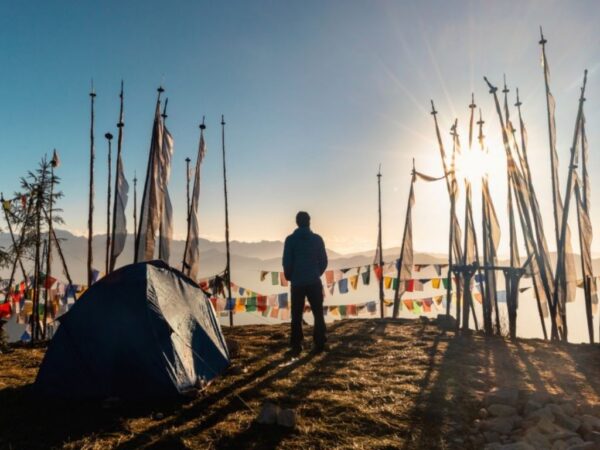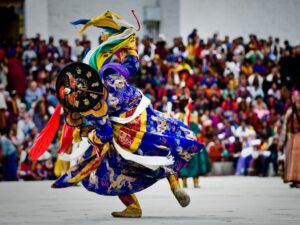Overview
This 12-day trek offers a perfect combination of cultural discovery and breathtaking natural beauty. Starting in Paro, you’ll explore ancient monasteries, cultural landmarks, and pristine valleys before trekking through Bhutan’s stunning landscapes. With spectacular views of the country’s tallest peaks, this adventure blends cultural immersion with outdoor thrills, ensuring an unforgettable experience in the heart of the Himalayas.
Included/Excluded
- The Bhutan SDF
- All accommodations
- Meals and mineral water
- A licensed English-speaking guide
- A driver and vehicle
- Air fare
- A visa fee of US $40
- Alcohol
- Gifts/Souvenirs
- Travel insurance and personal bills
- Museums & Monument Fees
Tour Plan
Day 1: Arrival in Paro
Upon arrival in Paro, you’ll be greeted by a representative from your tour company and escorted to your hotel. In the evening, explore Paro’s lively market before settling in for the night.
Day 2: Explore Paro
Begin your day with a visit to the National Museum, housed in the Ta Dzong, and then explore Rinpung Dzong. In the afternoon, visit Kyichu Lhakhang, one of Bhutan’s oldest and most sacred temples.
Day 3: Trek from Paro to Shana (17km, 5-6 hours)
Your trek starts at Drukgyel Dzong, descending through fields and woodlands before following the Paro River to the Sharna Zampa campsite.
Day 4: Trek from Shana to Soi Thangthangkha (20km, 7-8 hours)
Today, follow the river through a stunning forested valley. The trail offers a mix of ascents and descents, and you’ll reach your campsite at Soi Thangthangka after a full day of trekking.
Day 5: Trek from Soi Thangthangka to Jangothang (19km, 7-8 hours)
Ascend gradually beyond the tree line, with stunning views along the way. Reach Jangothang, your campsite, offering panoramic views of Jomolhari.
Day 6: Trek from Jangothang to Lingshi (18km, 7-8 hours)
Today’s trek offers magnificent views of Jomolhari, Jichu Drake, and Tserimgang as you cross the Nyele-la pass and descend into the Lingshi Valley.
Day 7: Trek from Lingshi to Shodu (22km, 8-9 hours)
The trail climbs towards Yeli-la pass, where you’ll enjoy incredible views of Bhutan’s peaks before descending alongside the river to your campsite at Shodu.
Day 8: Trek from Shodu to Barshong (16km, 6-7 hours)
Trek through forests and along rivers, with waterfalls cascading down the cliffs as you make your way to Barshong Dzong’s ruins.
Day 9: Trek from Barshong to Dolam Kencho (15km, 5-6 hours)
The trail leads you through beautiful forests and pastures before descending to a river and climbing to a serene meadow for your overnight camp.
Day 10: Trek from Dolam Kencho to Dodena, then drive to Thimphu (8km, 3 hours)
Today’s trek ends at Dodena, where a vehicle will transfer you to Thimphu for an overnight stay in the capital.
Day 11: Thimphu to Paro
Spend the day exploring Thimphu’s cultural sites, including the National Memorial Chorten and Tashichhodzong. In the evening, drive to Paro.
Day 12: Departure from Paro
After breakfast, you’ll be transferred to Paro Airport for your flight, concluding your incredible Bhutanese adventure.
Tour Map
Frequently Asked Questions
Bhutan is a year-round destination. There are four seasons: summer (June to August), autumn (September to November), winter (December to February) and spring (March to May). But because of the range of altitudes in the country, and the influence of the north Indian monsoons, the climate is incredibly varied.
In the south, the humid, subtropical climate is fairly consistent year-round, with temperatures between 15oC and 30oC. Central Bhutan, with its temperate forests, has a more seasonal climate, with warm summers and cool, dry winters. The northern regions are much colder during winter. Because of the high altitude, mountain peaks are snowy year-round and the lower reaches remain cool in summer.
In summer, the Indian monsoon season runs from late June or July to late September, mostly affecting the southern regions. Most farming activities take place in the summer, when crops thrive in verdant landscapes.
Autumn, from late September or early October to late November, follows the rainy season. It is characterised by bright, sunny days and some early snowfall at higher elevations. It’s the season of feasts and festivals as farmers reap the fruits of their work.
From late November until March, the crisp, clear and sunny winter sets in, with frost throughout much of the country and snowfall common above elevations of 3,000 metres. The winter northeast monsoon brings gale-force winds at the highest altitudes through high mountain passes, giving Bhutan the name Drukyul, which means Land of the Thunder Dragon in Dzongkha (Bhutan’s national language).
Bhutan’s generally dry spring starts in early March and lasts until mid-April. It is a botanist’s delight, with nature in full bloom. Summer weather commences in mid-April with occasional showers and continues to late June.
Visitors of all nationalities, except those from India, require a visa before entering Bhutan. For all visitors, except those from Bangladesh and the Maldives, this visa must be applied for and approved in advance of travel. Visitors from Bangladesh and the Maldives also require a visa, but this can be applied for and approved either in advance of travel or upon arrival in Bhutan.
Visitors from India are able to apply for a permit but are required to hold an Indian passport or an Indian voter ID card. For Indian nationals under the age of 18, a passport or a birth certificate can be used to enter and they must be accompanied by a legal guardian.
Nationals from Switzerland and Thailand holding diplomatic or government-official passports are eligible for a visa at their port of entry.
A correctly input visa application can take up to five days to process.
There is a one-off fee of US$40 for the processing of your application. This is payable at the same time as your Sustainable Development Fee (SDF), as part of the process of submitting your visa application.
All treks must be undertaken with an accredited tour operator or guide. Your tour operator will assist you with all the necessary logistics and safety precautions.
Please contact our hosts for the Department of Tourism’s list of approved tourism services.
The Sustainable Development Fee (SDF) is a daily levy paid by visitors to support Bhutan’s development. Since the kingdom first opened its doors in 1974, guests have played a critical role in our country’s growth.
The SDF is collected by the national exchequer and funds are allocated to various projects that create long-term, sustainable opportunities for the Bhutanese people, through free healthcare, education and training, upskilling the tourism and hospitality industry, improved infrastructure, environmental preservation and conservation, cultural preservation programmes and initiatives that support local businesses and economies. The SDF is also a vital means of maintaining the exceptional forest cover and carbon-neutrality for which our small nation is world-renowned and globally critical. The SDF also helps us to ensure that we can continue to offer guests tranquillity and an intimate experience.
The SDF is USD 100 per night for adults from all countries except for India. Children aged between 6 years and who have not yet turned 12 are eligible to pay USD 50 per night. Children who have not yet turned 6 years old do not have to pay any SDF.
The SDF for Indian nationals (showing a valid Indian passport or Voter ID card) is Nu. 1,200 (or the equivalent amount in Indian rupees) per person, per night. Children aged between 6 years and who have not yet turned 12 are eligible to pay Nu./INR 600 per night. Children who have not yet turned 6 years old do not have to pay any SDF.
SIM cards can be purchased from the Paro International Airport’s visitor information centre on arrival, or from branch offices of Bhutan Telecom and TashiCell, or from authorised agents in towns.
There are no rules about what visitors should wear. However if you are planning to visit places of religious significance, respectful smart-casual clothing that covers your body from shoulders to knees is appropriate and appreciated.
Yes, permits are required to enter National Parks in Bhutan. However the process can be done online and the permit should be issued quickly. Please visit this link for more information: https://docs.google.com/forms/d/e/1FAIpQLScM4k5SPaGI_GnV6NJuQHstpS5ai9G4wOlpLSq0fsy73EZK7A/viewform
While most monuments in Bhutan are free, some are chargeable. For the full list of monument fees, please click here for more information. Children below 18 years will have a 50% concession and children aged five years and below will be exempted. Most monuments are open from 9am – 5pm each day. In June 2023 it was announced that foreign visitors can now visit monuments whenever they are open to the general public, without any restrictions.















